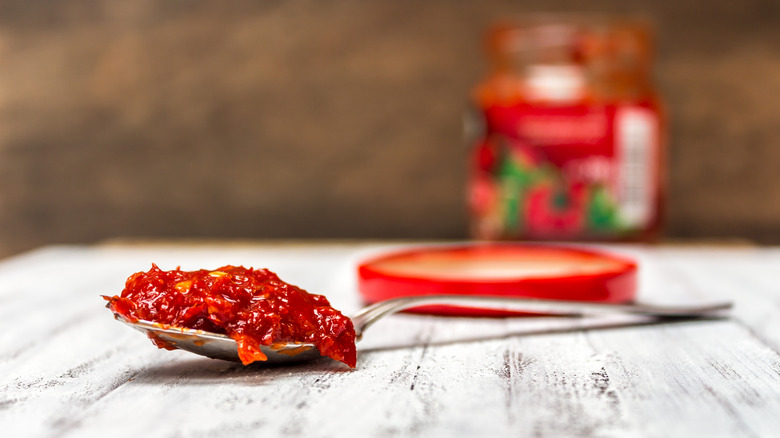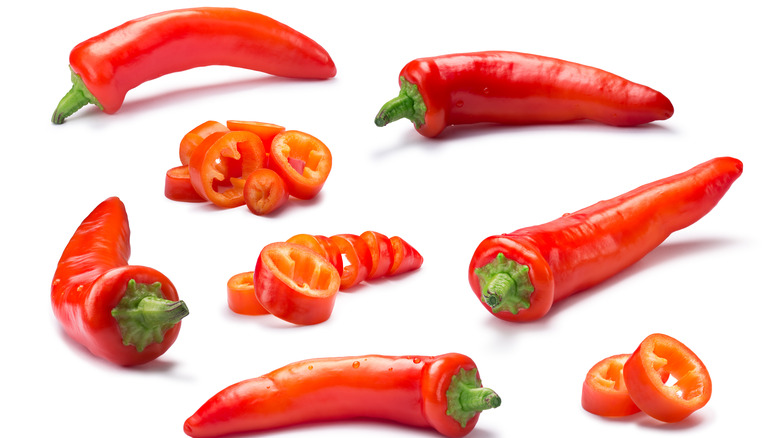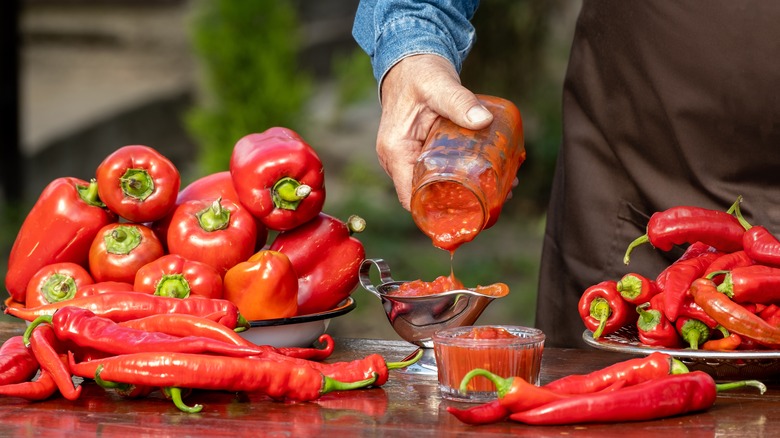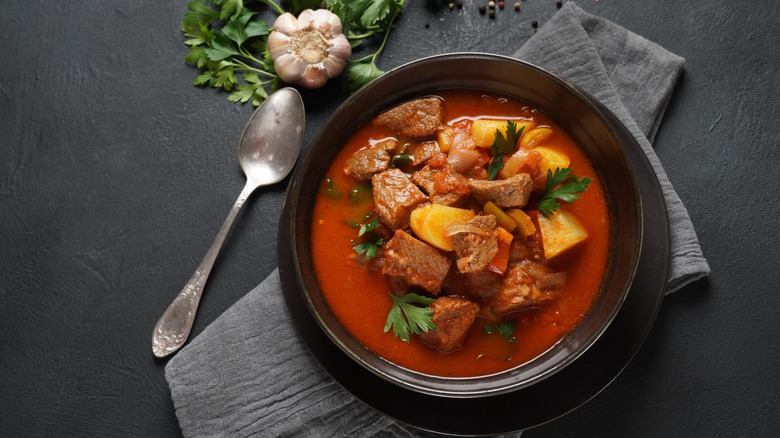Hungarian Paprika Paste Is The Rich Ingredient You Need For Better Stews
It's hard to believe that all pepper varieties — from bell to jalapenos and poblano — hailed from a common plant. Native to South America, the fruit's seeds were carried globally across trade routes and integrated into cuisines worldwide. Its intercontinental movement brought it to Central Europe, too, where it became especially popular in Hungary. The fruit is now a central part of Hungarian cuisine, as well as the nation's symbol.
And although dried Hungarian paprika may receive most of the attention, it's not the only processed form of the pepper. There's also Hungarian pepper paste, which offers a similar vivid red color but with a different texture. Thick, often salty, and packed with flavor-dense flavor, culinary excursions through Hungary first showed us how a dollop can imbue a powerful pepper flavor. Then, with subsequent use in our home kitchen, we've untapped its truly irreplaceable qualities for building aromatic stews. Plus, its sturdy shelf-life means it's easy to use a small amount at a time, perfected through many rounds of experimentation. So, let's dive into what this wonderous aromatic paste is all about.
What is Hungarian paprika paste?
The peppers used to produce both the spice and the paste were likely introduced to the European nation by the Turks around the 16th century. However, the fruit didn't become domestically popular until the 18th century — when the paste first entered Hungarian kitchens. Nowadays, it's a beloved culinary component used to build classic dishes such as chicken paprikash and goulash. A tube or jar of paprika paste can nearly always be found in Hungarian pantries and restaurants alike.
Just like the spice, Hungarian paprika paste exists in several varieties. The most common is Piros Arany, which has a liquid consistency accompanied by a spicy kick. Such a paste is found in sweeter deviations named Csemege, with varying levels of heat based on the producer. A thicker version of paprika paste is called Erős Pista, and often contains some pulverized seeds, as well as more salt — much like a sambal. Some producers also add further spices like cumin, onions, and tomatoes, turning it into a convenient all-in-one seasoning.
How is Hungarian paprika paste made?
This aromatic pepper paste is made from varietals of the Hungarian wax pepper. Although such a type is sometimes green, the paste employs red, fully-ripened fruits to lend its bold color. To achieve its desired flavor, producers often blend together varying peppers, combining notes of spice and sweetness.
Unlike with ground paprika, the paste does not dry the pepper for production. Instead, the peppers are cleaned and either fully or partially deseeded. Then, the fruit are ground, using machinery similar to a meat grinder. Next, salt is added, along with citric acid, for some tang and preservative qualities. For the more spiced Erős Pista, additional flavorings are introduced during this time. The mixture is rested for several hours, allowing flavors to meld together. It's then sieved, with much of the liquid discarded. Varying paste textures are achieved by utilizing sieves of different sizes. The paste is then placed into jars or tubes, ready for use.
What does Hungarian paprika taste like?
Since Hungarian paprika paste utilizes varying pepper types, its flavor can vary. Like its dried counterpart, it frequently boasts pleasantly sweet, complex undertones. However, unlike most versions of the spice, it packs in more heat, reaching up to 15,000 Scoville units. There are some tangy notes due to the integrated acid, but more dominantly, the main flavor is salt. As opposed to other pepper products, don't expect smokey notes, like with Spanish pepper pastes or canned chipotle peppers.
Especially when stored in a tube, Hungarian paprika paste may look similar to tomato paste — and there are parallels in flavor and consistency. Both pack a fruity dose of umami, with a bright, yet rich flavor, backed by a thick texture. In the case of Erős Pista, which carries a bolder palette, its taste is reminiscent of harissa. So, if you're looking for a pepper flavor with a bold character that won't overwhelm with heat quite like other chili pastes, this paprika variety is an excellent choice.
How to cook with Hungarian paprika paste
In Hungary, paprika paste is used to form the aromatic backbone of dishes, often in addition to the dried version of the spice. To enhance its flavor, it's typically sizzled into hot oil right after onions and other aromatics. Such a base then serves as a backbone for classic dishes such as chicken paprikash, Hungarian goulash, or halászlé — a fisherman's stew.
In addition to building dishes, the paprika paste can be enjoyed during dining, too. With its potent character, it's often stirred into a prepared soup or stew to amplify the flavor. Or, it can be a side dipping sauce for a prepared protein like pork or chicken. And its easy-to-like flavor can extend past Hungarian dishes, too. Use it as a marinade for grilled foods; it'll meld with proteins like pork, chicken, and white-flesh fish. Add some to a pasta sauce alongside tomato paste, or use it to make a paprika-tinged soup from scratch. Its delicious palate will mesh with a variety of applications.
Where to buy Hungarian paprika paste
As per its name, there's no better place to purchase Hungarian paprika paste than in the country itself. Many brands are readily carried across groceries in Hungary, usually with extensive selections. Meanwhile, smaller-scale producers offer their rendition in market halls, showcasing a more homegrown produced spin. Finding the condiment stateside can be more difficult. In certain cities, the best bet is to head to a Hungarian specialty store. Some stores may stock the condiment in their imported food selection. Or, for ease, order Hungarian paprika paste online.
Especially when refrigerated, Hungarian paprika paste preserves its flavor for long durations. It doesn't spoil to an inedible state, but recommended consumption is within two years. Check the package's best-by date to ensure the most aromatic state. And with such delicious flavor and ease of use, a package going stale is unlikely. Hungarian paprika paste will dependably make a variety of dishes shine.
Nutritional information about Hungarian paprika paste
Even after processing, paprika contains beneficial nutritional advantages, notes Healthline. Most prominently, it's loaded with Vitamin A. Such a compound aids with vision and reproductive processes and offers immune support through contained antioxidants, per Mayo Clinic. Hungarian paprika provides even more enhancement of vision through its Vitamin E content — alongside antioxidants such as lutein and zeaxanthin. And just like Vitamin A, Vitamin E also offers immune support, as well as clot-prevention, via Harvard School of Public Health.
Other helpful compounds in Hungarian paprika include carotenoids, which lower the risk of cancer. And spicier versions of the paste offer added benefits through capsaicin. Such a compound reduces inflammation, aiding with digestive issues and arthritis. So, with such an abundance of benefits, feel free to use Hungarian paprika paste regularly– it'll improve both health and flavor.




